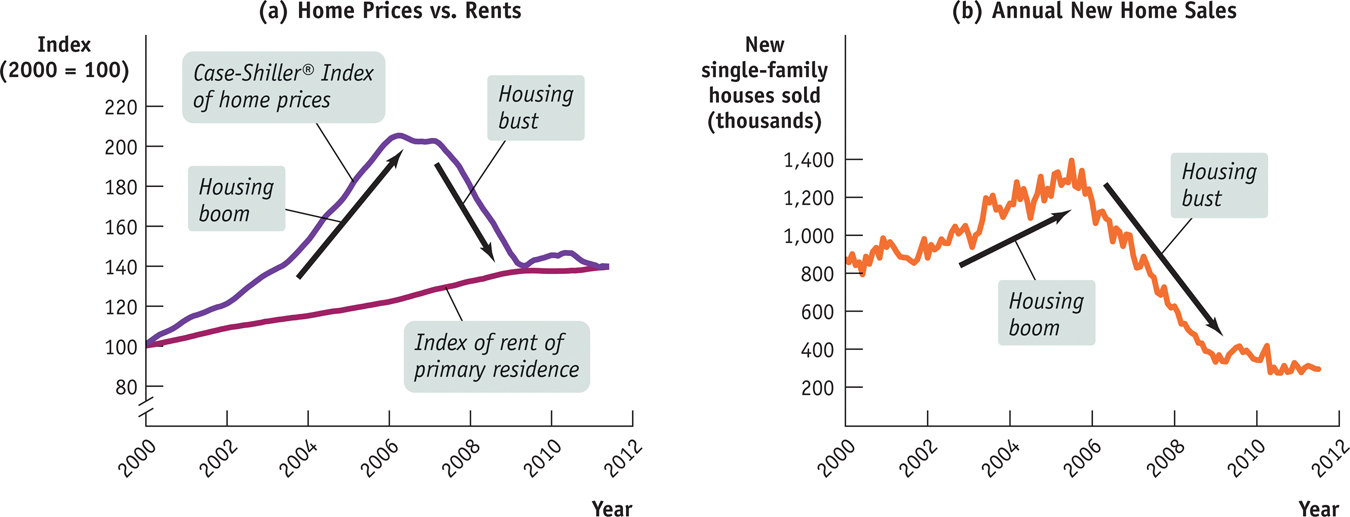1.4 Module 23: The Financial System

Tupungato/Thinkstock
WHAT YOU WILL LEARN
 The purpose of the four main types of financial assets: stocks, bonds, loans, and bank deposits
The purpose of the four main types of financial assets: stocks, bonds, loans, and bank deposits
 How financial intermediaries help investors achieve diversification
How financial intermediaries help investors achieve diversification
 How financial fluctuations occur in the financial system
How financial fluctuations occur in the financial system
Understanding the Financial System
A well-
A household’s wealth is the value of its accumulated savings.
Financial markets are where households invest their current savings and their accumulated savings, or wealth, by purchasing financial assets.
A financial asset is a paper claim that entitles the buyer to future income from the seller.
A financial asset is a paper claim that entitles the buyer to future income from the seller. For example, when a saver lends funds to a company, the loan is a financial asset sold by the company that entitles the lender (the buyer of the financial asset) to future income from the company.
A physical asset is a tangible object that can be used to generate future income.
A household can also invest its current savings or wealth by purchasing a physical asset, a tangible object that can be used to generate future income such as a preexisting house or preexisting piece of equipment. It gives the owner the right to dispose of the object as he or she wishes (for example, rent it or sell it).
A liability is a requirement to pay income in the future.
If you get a loan from your local bank—
In addition to loans, there are three other important kinds of financial assets: stocks, bonds, and bank deposits. Because a financial asset is a claim to future income that someone has to pay, it is also someone else’s liability. We’ll explain in detail shortly who bears the liability for each type of financial asset.
The four types of financial assets—
Earlier, in the context of the circular-
Three Tasks of a Financial System
Our earlier analysis of the loanable funds market ignored three important problems facing borrowers and lenders: transaction costs, risk, and the desire for liquidity. The three tasks of a financial system are to reduce these problems in a cost-
Transaction costs are the expenses of negotiating and executing a deal.
Task 1: Reducing Transaction CostsThe expenses involved in actually putting together and executing a deal are known as transaction costs. For example, arranging a loan requires spending time and money negotiating the terms of the deal, verifying the borrower’s ability to pay, drawing up and executing legal documents, and so on.
Suppose a large business decided that it wanted to raise $1 billion for investment spending. No individual would be willing to lend that much. And negotiating individual loans from thousands of different people, each willing to lend a modest amount, would impose very large total costs because each individual transaction would incur a cost, with the result that the entire deal would probably be unprofitable.
Fortunately, there is another option: when large businesses want to borrow money, they either go to a bank or sell bonds in the bond market. Obtaining a loan from a bank avoids large transaction costs because it involves only a single borrower and a single lender. We’ll explain more about how bonds work shortly. For now, it is enough to know that the principal reason there is a bond market is that it allows companies to borrow large sums of money without incurring large transaction costs.
Financial risk is uncertainty about future outcomes that involve financial losses or gains.
Task 2: Reducing RiskAnother problem that real-
Most people experience the loss in welfare from losing a given amount of money more intensely than they experience the increase in welfare from gaining the same amount of money. A person who is more sensitive to a loss than to a gain of an equal dollar amount is called risk-
A well-
So, being risk-
By selling shares in her company, she reduces her personal losses if the profit is less than expected: she won’t have lost her other assets. But if things go well, the shareholders earn a share of the profit as a return on their investment.
By selling a share of her business, the owner has also achieved diversification: she has been able to invest in a way that lowers her total risk. She has maintained her investment in her bank account, a financial asset; in ownership of her house, a physical asset; and in ownership of the unsold portion of her business, a financial asset. These investments are likely to carry some risk of their own; for example, her bank may fail or her house may burn down (though in the United States it is likely that she is partly protected against these risks by insurance).
An individual can engage in diversification by investing in several different assets so that the possible losses are independent events.
But even in the absence of insurance, she is better off having maintained investments in these different assets because their different risks are unrelated, or independent, events. This means that her house is no more likely to burn down if her business does poorly and that her bank is no more likely to fail if her house burns down. To put it another way, if one asset performs poorly, it is very likely that her other assets will be unaffected and, as a result, her total risk of loss has been reduced. But if she had invested all her wealth in her business, she would have faced the prospect of losing everything if the business had performed poorly. By engaging in diversification—investing in several assets with unrelated, or independent, risks—
The desire to reduce total risk by engaging in diversification is why we have stocks and a stock market.
Task 3: Providing LiquidityFinancial systems also exist to provide investors with liquidity, a concern that—
An asset is liquid if it can be quickly converted into cash with relatively little loss of value.
An asset is illiquid if it cannot be quickly converted into cash with relatively little loss of value.
An asset is liquid if it can be quickly converted into cash with relatively little loss of value, illiquid if it cannot. As we’ll see, stocks and bonds are a partial answer to the problem of liquidity. Banks provide an additional way for individuals to hold liquid assets and still finance illiquid investment spending projects.
Now that we’ve learned the three ways the financial system helps lenders and borrowers make mutually beneficial deals—
Types of Financial Assets

In the modern economy there are four main types of financial assets: loans, bonds, stocks, and bank deposits. In addition, financial innovation has allowed the creation of a wide range of loan-
LoansA lending agreement made between an individual lender and an individual borrower is a loan. Individuals are likely to encounter loans in the form of a student loan or a bank loan to finance the purchase of a car or a house. Small businesses usually use bank loans to buy new equipment.
On the positive side, loans are typically tailored to the needs of the borrower. Before a small business can get a loan, it usually has to discuss its business plans, its profits, and so on with the lender. This results in a loan that meets the borrower’s needs and ability to pay.
On the negative side, making a loan to an individual person or a business involves a lot of transaction costs, such as the cost of negotiating the terms of the loan, investigating the borrower’s credit history and ability to repay, and so on. To minimize these costs, large borrowers such as major corporations and governments often take a more streamlined approach: they sell (or issue) bonds.
BondsAn IOU issued by a borrower is called a bond. Normally, the seller of the bond promises to pay a fixed sum of interest each year and to repay the principal—
A bond issuer sells a number of bonds with a given interest rate and maturity date to anyone willing to buy them, a process that avoids costly negotiation of the terms of a loan with many individual lenders.
A default occurs when a borrower fails to make payments as specified by the loan or bond contract.
Bond purchasers can acquire information free of charge on the quality of the bond issuer, such as the bond issuer’s credit history, from bond-
Another important advantage of bonds is that they are easy to resell. This provides liquidity to bond purchasers. Indeed, a bond will often pass through many hands before it finally comes due. Loans, in contrast, are much more difficult to resell because, unlike bonds, they are not standardized: they differ in size, quality, terms, and so on, making them a lot less liquid than bonds.
A loan-
Loan-
However, with so many loans packaged together, it can be difficult to assess the true quality of the asset. That difficulty came to haunt investors during the financial crisis of 2008, when the bursting of the housing bubble led to widespread defaults on mortgages and large losses for holders of “supposedly safe” mortgage-
StocksA stock is a share in the ownership of a company. A share of stock is a financial asset from its owner’s point of view and a liability from the company’s point of view. Not all companies sell shares of their stock; “privately held” companies are owned by an individual or a few partners, who get to keep all of the company’s profit.
Most large companies, however, do sell stock. For example, Microsoft has over 8 billion shares outstanding; if you buy one of those shares, you are entitled to one-

Why does Microsoft, historically a very profitable company, allow you to buy a share in its ownership? Why don’t Bill Gates and Paul Allen, the two founders of Microsoft, keep complete ownership for themselves and just sell bonds for their investment spending needs? The reason is risk: few individuals are risk-
But stocks do more than reduce the risk that business owners face. The existence of stocks improves society’s welfare and improves the welfare of investors who buy stocks. Shareowners are able to enjoy the higher returns over time that stocks generally offer in comparison to bonds. Over the past century, stocks have typically yielded about 7% after adjusting for inflation; bonds have yielded only about 2%. But as investment companies warn you, “past performance is no guarantee of future performance.”
And there is a downside: owning the stock of a given company is riskier than owning a bond issued by the same company. Why? Loosely speaking, a bond is a promise while a stock is a hope: by law, a company must pay what it owes its lenders before it distributes any profit to its shareholders. And if the company should fail (that is, be unable to pay its interest obligations and declare bankruptcy), its physical and financial assets go to its bondholders—
But the financial system has devised ways to help investors as well as business owners simultaneously manage risk and enjoy somewhat higher returns through the services of institutions known as financial intermediaries.
Financial Intermediaries
financial intermediary is an institution that transforms the funds it gathers from many individuals into financial assets.
A financial intermediary is an institution that transforms funds gathered from many individuals into financial assets. The most important types of financial intermediaries are mutual funds, pension funds, life insurance companies, and banks. About three-
Mutual FundsOwning shares of a company entails accepting risk in return for a higher potential reward. But it should come as no surprise that stock investors can lower their total risk by engaging in diversification.
By owning a diversified portfolio of stocks—
However, for individuals who don’t have a large amount of money to invest—
A mutual fund is a financial intermediary that creates a stock portfolio and then resells shares of this portfolio to individual investors.
A mutual fund is a financial intermediary that creates a stock portfolio by buying and holding shares in companies and then selling shares of the stock portfolio to individual investors. By buying these shares, investors with a relatively small amount of money to invest can indirectly hold a diversified portfolio, achieving a better return for any given level of risk than they could otherwise achieve.
Many mutual funds also perform market research on the companies they invest in. This is important because there are thousands of stock-
The mutual fund industry represents a huge portion of the modern U.S. economy, not just of the U.S. financial system. In total, U.S. mutual funds had assets of $14.8 trillion at the end of 2013.
We should mention, by the way, that mutual funds charge fees for their services. These fees are quite small for mutual funds that simply hold a diversified portfolio of stocks, without trying to pick winners. But the fees charged by mutual funds that claim to have special expertise in investing your money can be quite high.
pension fund is a type of mutual fund that holds assets in order to provide retirement income to its members.
Pension Funds and Life Insurance CompaniesIn addition to mutual funds, many Americans have holdings in pension funds, nonprofit institutions that collect the savings of their members and invest those funds in a wide variety of assets, providing their members with income when they retire. Although pension funds are subject to some special rules and receive special treatment for tax purposes, they function much like mutual funds. They invest in a diverse array of financial assets, allowing their members to achieve more cost-
A life insurance company sells policies that guarantee a payment to a policyholder’s beneficiaries when the policyholder dies.
Americans also have substantial holdings in the policies of life insurance companies, which guarantee a payment to the policyholder’s beneficiaries (typically, the family) when the policyholder dies. By enabling policyholders to cushion their beneficiaries from financial hardship arising from their death, life insurance companies also improve welfare by reducing risk.
BanksRecall that, other things equal, people want assets that can be readily converted into cash. Bonds and stocks are much more liquid than physical assets or loans, yet the transaction cost of selling bonds or stocks to meet a sudden expense can be large. Furthermore, for many small and moderate-
A bank deposit is a claim on a bank that obliges the bank to give the depositor his or her cash when demanded.
A bank works by first accepting funds from depositors: when you put your money in a bank, you are essentially becoming a lender by lending the bank your money. In return, you receive credit for a bank deposit—a claim on the bank, which is obliged to give you your cash if and when you demand it.
So a bank deposit is a financial asset owned by the depositor and a liability of the bank that holds it.
A bank is a financial intermediary that provides liquid assets in the form of bank deposits to lenders and uses those funds to finance the illiquid investment spending needs of borrowers.
A bank, however, keeps only a fraction of its customers’ deposits in the form of ready cash. Most of its deposits are lent out to businesses, buyers of new homes, and other borrowers. These loans come with a long-

In essence, a bank is engaging in a kind of mismatch: lending for long periods of time while subject to the condition that its depositors could demand their funds back at any time. How can it manage that?
The bank counts on the fact that, on average, only a small fraction of its depositors will want their cash at the same time. On any given day, some people will make withdrawals and others will make new deposits; these will roughly cancel each other out. So the bank needs to keep only a limited amount of cash on hand to satisfy its depositors.
In addition, if a bank becomes financially incapable of paying its depositors, individual bank deposits are guaranteed to depositors up to $250,000 by the Federal Deposit Insurance Corporation, or FDIC, a federal agency. This reduces the risk to a depositor of holding a bank deposit, in turn reducing the incentive to withdraw funds if concerns about the financial state of the bank should arise. So, under normal conditions, banks need hold only a fraction of their depositors’ cash.
By reconciling the needs of savers for liquid assets with the needs of borrowers for long-
Financial Fluctuations and Macroeconomic Policy
We’ve learned that the financial system is an essential part of the economy; without stock markets, bond markets, and banks, long-

How should economists and policy makers deal with the fact that asset prices fluctuate a lot and that these fluctuations can have important economic effects? This question has become one of the major problems for macroeconomic policy. On one side, policy makers are reluctant to assume that the market is wrong—
On the other side, the past 15 years were marked by not one but two huge asset bubbles, each of which created major macroeconomic problems when it burst. In the late 1990s the prices of technology stocks, including but not limited to dot-
These events have led to a fierce debate among economists over whether policy makers should try to pop asset bubbles before they get too big.
THE GREAT AMERICAN HOUSING BUBBLE
Between 2000 and 2006, there was a huge increase in the price of houses in America. By the summer of 2006, home prices were well over twice as high as they had been in January 2000 in a number of major U.S. metropolitan areas, including Los Angeles, San Diego, San Francisco, Washington, Miami, Las Vegas, and New York. By 2004, as the increase in home prices accelerated, a number of economists (including the authors of this textbook) argued that this price increase was excessive—
It was certainly true that home prices rose much more than the cost of renting a comparable place to live. Panel (a) of Figure 23-1 compares a widely used index of U.S. housing prices with the U.S. government’s index of the cost of renting, both shown as index numbers with January 2000 = 100. Home prices shot up, even though rental rates grew only gradually.

Yet there were also a number of economists who argued that the rise in housing prices was completely justified. They pointed, in particular, to interest rates that were unusually low in the years of rapid price increases, and they argued that low interest rates combined with other factors, such as growing population, explained the surge in prices. Alan Greenspan, then chairman of the Federal Reserve, conceded in 2005 that there might be some “froth” in the markets but denied that there was any national bubble.
Unfortunately, it turned out that the skeptics were right. Greenspan himself would later concede that there had, in fact, been a huge national bubble. In 2006, as home prices began to level off, it became apparent that many buyers had held unrealistic expectations about future prices. As home prices began to fall, expectations of future increases in home prices were revised downward, precipitating a sudden and dramatic collapse in prices. And with home prices falling, the demand for housing fell drastically, as illustrated by panel (b) of Figure 23-1.
The implosion in housing, in turn, created numerous economic difficulties, including severe stress on the banking system.
Module 23 Review
Solutions appear at the back of the book.
Check Your Understanding
Rank the following assets from the lowest level to the highest level of (i) transaction costs, (ii) risk, (iii) liquidity. Ties are acceptable for items that have indistinguishable rankings.
-
a. a bank deposit with a guaranteed interest rate
-
b. a share of a highly diversified mutual fund, which can be quickly sold
-
c. a share of the family business, which can be sold only if you find a buyer and all other family members agree to the sale
-
What relationship would you expect to find between the level of development of a country’s financial system and its level of economic development? Explain in terms of the country’s levels of savings and investment spending.
Multiple-
Question
NMm9sBFtbywv6lKLwQOdGdlACLLazJcYXWtey/CO6DQE/XKcxn23ec5/eYcxJCjIThNvQRDFRsum/GuruaQxWHNpYNCltvQBPga8ENHtbwy/2SOpdfEL6hdw9a06koakcjm7rYSU+hBNRQOxyjr9RHo/lfgehDQ/XnISekOBT2RBwVXcHutZk/1JpBSyQiiMoOvQ0DlOX5ahLjAVjPZexLXuWR7f2seFVk38brVmWB6/4lj1ANiesXRLW0eWdTEc+5v2QB8PERuftXrQu9U6iyolzQYWs9auzz5evMD9GVf9MHa5qwnxky4bo/mtnmWBSNEeYV0L5ag5z2V2Y8W208juJNmn2P8woOLOiFA+l8WtaF/JQuestion
jfiH0nxSdPfwzx4zzQZE04YUIFGhwDwnSuaO/xq8leviwYbjcS4XeKOwqxR1H+xUKqZRdFDEfL/7HjQ+DrCRw41rZbVsb+rcc7iq3QLarTHfzXJq9gZERKgrvOSncvm//2xL7nMuCaX3C6caFB1QNZfKDS0lmieRj6MijdmDKrBxD2IXHKaiP3D1SO+mL6ERL+ub+b+LwXokG6miZnhwvZGf4miQWdfwMkZ8aWbBXY3+slalv+q6NRwxNv5WrGbxjN2iRIkSdNTxmOrQlr0+lQ9zmNSDTcp/vZpHIN8K5JQLOFS/IxNv7+Z9uNliKZYFfGJDusi2PqZdw4H39UOV3ZuHV0v9YWo0Kz7irQ==Question
h1/8HdDSH+RDSoAUdRv7klsQMIB2Cxl5DyBPC0EFls4COXJbr+EsIu9zFXNow52ga8BptrE1I15qj4pOxBbBO6yXse6YkQP0HXKisygr2XeAAu/2lKAPrYKvckqjtFU1pl9IH22sDfkumrw5PD/KJJGzUtyBLpfNWKATWWS62/gosUxuwJT7JBzImNgFsYd69vGy/rlg3xuCGUIpasBN++AH2azKlFn8tZlMVBl/ZQivsmqKvGFQ/6YTZBLoqRJqVlReZlHRoVY/Zi7SnxkofkbLp5o3bQwc4ZuVpPBqYzU2MGLkQuestion
odfkXP9G0UHKx0Llaj7ZKALT/BxNZlDuVuifHycIwHqfPOq5wlQoXVI7EULitWoWMHxUMyOKWZyLGPukl+uYcim7a0gLwz1GhhGaI3mcBfVxdqzhyqxjlVflvtZOAxTXlFhY1VWkgMJ8xJOmGmIQYmWZ0s/+pa6tY66xQOW63Z8RNATE9ALVMQwKLmOGs6RkPtmQ7WEuZsGPpPRKt69on+65SdEA8p0XptE4lfVOeULgGl1ckxsZ808I+qgQZAogFq4LYo6pCwvqGoqhsoMkK/9Zr9m2ceTBBCU4uGGMdpgSTAGX5Tew58ScOGvrXDMORYVIqfo0KzOKHr1LC13DV36fTzzQmny8thxNTfDqBtWS/GbBMcN6qacaMUp3lKIw0zzsKxxdm73R6QoIZF3mQVaB1vU7tGWPQuestion
JNERDcmKDgZzEORVUIugSs78oXp5jhRpvqQZcu6D30ps81KbjE90AHB0aBnCIFPTBTFAdAlu0/QdvrIS3soGez3b7ztCSHSX/BpnQWiKP2c5u5GgEDOfid356Io0son2g/t5R7/m/lzXEmnkHOTqMDW3QVO8DQhDIC5TH8qcleUigcwQ8otIXzqNGGbp2zaf3z1L6ZgV/zyvxQdeyg9fK9IX3PTnrq4FD5/ImeK5iqXFPfSQ8VGe3kk9+jYKBXZl+IShQnOwfS+yokCVfebsbZ9eXaYsU8EuA8uf8i0+PVE//wm8l5qsQI1fTqbm4G7jsNVLHAfbn67Z4+jz2E5iLumXFcuF27oy2Vv0WAChHxXQFD6rmQZwL6/P2V4bG5WzMxoRqz/rFgd/JGxJmpqnntUicV+dJjhc
Critical-
List and describe the four most important types of financial intermediaries.